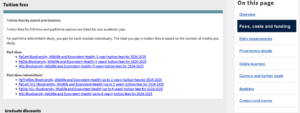Hug a laptop – a practical guide to conducting usability testing remotely on mobile devices
I conduct a lot of usability testing remotely and I need to test on both desktop and mobile devices. It’s tricky to create a realistic environment for testing remotely on mobile devices. I’ve found a method called ‘laptop hugging’ that works really well.
Context
An important consideration in delivering the future state website provision for prospective students is what their experience will be like on a mobile device. As a team we have adopted a mobile first approach to how we design.
What is mobile first?
Mobile first is a design approach that embraces the constraints of smaller screens and focuses on what is indispensable to users to improve the overall mobile experience.
This approach involves starting the design process by designing for the smallest device first and progressively enhancing the design features for larger layouts.
Learn more about mobile first design: webflow.com’s guide to mobile first design
We’ve been using this approach to design different components for the study site such as:
- In-page navigation
- Search and filter
- A-Z listings
- Subject listings

In-page navigation component on mobile for smallest screen size

In-page navigation component on desktop for largest screen size
Problems encountered testing remotely on mobile
I’ve tried different approaches to create a realistic remote environment for testing on mobile devices. I’ve asked participants to use software that mimics a mobile view on desktop, and I’ve asked them to connect remotely with their mobile device and share their screen.
What I can’t get with these approaches is an understanding of how each participant physically interacts with their mobile device while completing tasks as I would if I was in-person with them.
Hug a laptop
I was looking for an alternative approach to the methods I had used and started to do some searching online.
I came across a video that showed an approach I thought met the criteria I was looking for. It requires the particpipant to swing their laptop around so that their camera is facing away from them and allows the facilitator to record what they are doing in front of them.
The hug a laptop method: YouTube video detailing how to use the method
I’ve conducted several rounds of usability testing using this method. While it’s a simple method to use successfully, I’ve learnt through trial and error that there are additional things to consider for a facilitator who wants to use it.
Best practice for creating an optimal test environment
Before the usability testing session
- In your recruitment screener ensure that you ask each participant if they have a mobile device to test with and access to a desk (this is essential to support the participants hands which prevents too much movement of the mobile device during the recording)
Before asking the particpipant to turn the laptop around
- Ask the participant to put their phone on silent (this ensures no messages pop-up during recording but also protects their privacy)
- Explain the method as shown in the video above but before turning the laptop around ask the participant if there is anything in the room that they don’t want seen on camera (give them the opportunity to address their environment if needed)
- Ask the particpipant to reduce the brightness of their laptop screen (it can reflect on the screen of the mobile device and make it difficult for the facilitator to see)
After the laptop is turned around
- Take time to arrange the optimal hand positioning of the particpipant and their laptop camera so you can see the screen clearly
- Adjust the brightness of the screen of the mobile device (not always necessary but often is depending on lighting conditions of the environment)
Once you have followed these steps you should be able to clearly see the screen of your participants mobile device.

A University of Edinburgh student completing usability tasks on their mobile device that can be easily recorded
Try it yourself
If you need to conduct remote usability testing on mobile devices go ahead and give it a try.
I’ve been sharing this method with colleagues across the University involved in other projects who are not sure how to get started with this type of testing. I’ve found that it’s easy for others to pick up and use.
This method is so helpful and easy to use. We know we need to do some usability testing for our new short courses platform on mobile devices and find remote testing more practical for recruitment purposes. We weren’t sure how we were going to achieve this so thanks to Pete for sharing this approach with us.
Scott Coutts, Marketing and Communications Manager (Online Learning), Educational Design and Engagement
Next steps
This method will allow you to capture usability issues users experience while using your product on their mobile devices.
A critical next step is to share that insight with the relevant stakeholders. This might be others in your project or colleagues across the University. I strongly recommend an approach that I take after each round of usability testing which is a collaborative review.
How to run a collaborative usability test review: my blog post on how and why I do this
Usability testing is a fundamental skill that I support the rest of my team to develop and most of us have written about our experiences of doing it.
Our team experience of usability testing: a collection of blog posts on usability testing written by different members of our team
I always enjoy talking to others about what I do and supporting them in any way I can. Please get in touch if you want to talk about anything I’ve written about here.




good article. Pete’s suggestion is spot on! Remote usability testing is both practical and effective, especially for mobile applications. These tests for your short course platform will help you optimize the user experience and further develop your platform. thanks.